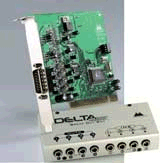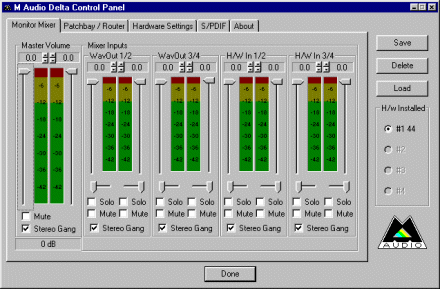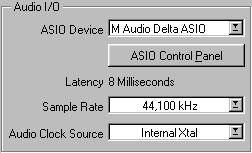Users' Opinion - Delta 44


I had a DMAN 2044, of which I was very satisfied, see the page on the subject, but technologies develop fast, and I wanted to take benefit from the last one signed Steinberg : the ASIO 2. For reminding, I recall that you mustn't forget that ASIO 2 is a technology which makes it possible to the manufacturers to conceive some drivers much more efficient than the Windows standard ones, which suffer especially from one thing, latency. Latency ? But yes ! You know, this phenomenon which consists in the following : when you play a guitar note, the Cubase monitoring send it back to you, hop, 750 milliseconds later. This same latency appears too with the VST Instruments : when you play a key from your master keyboard, the note is played also 750 ms later. Unusable. With ASIO 2, no more latency ! It gets down to 8, sometimes lower. It's starting to be interesting, no ? So, at the risk of changing the soundcard, it's better to stay with the same manufacturer who made me satisfied a first time, hence the buying of a DELTA 44.
The Delta 44 is just a much recent DMAN 44. You have 4 analogic inputs / outputs, but this time, the external box is offered at the pruchase, it is not an option. The connectical is thus easier and it is a little bit less untidy at home ,o)
The installation doesn't give any problem, except that... Except that, like too much often, for keen competition reasons, the hardware part is finalized, but not the software one. Translation : the drivers released with the floppy disk are shit. Only one issue : go fishing the last version !
Once installed, the card proposes its own manager, which replaces the Windoz mixboard, it looks like this :

With this small marvel, you will be able to do almost everything. You can route an input or an output to any input or output. Those who don't have any mixboard will be delighted having some monitoring.
 With this software you will be able
also to adjust all the card parameters. Besides the output or recording
level (-10 dB or + 4 dB), you will be able especially to adjust the buffers,
which will have a direct consequence on latency. With the adjustment I'm
showing you now, you have 8 ms of latency at 44.1 kHz. It's widely enough.
Wanting less is ridiculous, you have always putted up with Midi latency,
no ? I should even say that it is playable till 15 ms.
With this software you will be able
also to adjust all the card parameters. Besides the output or recording
level (-10 dB or + 4 dB), you will be able especially to adjust the buffers,
which will have a direct consequence on latency. With the adjustment I'm
showing you now, you have 8 ms of latency at 44.1 kHz. It's widely enough.
Wanting less is ridiculous, you have always putted up with Midi latency,
no ? I should even say that it is playable till 15 ms.
The only very fucking thing with these adjustments, is that you need either to start again Cubase, nor to load the MME driver and then load again the ASIO driver, so that Cubase will take in account the done modifications. Toilsome, but well, you must be content with this... Especially to have this :

Regarding the sound, it's perfect, any noise, I felt as if all the frequencies were sent back correctly or with fidelity. Anyway, I have a little home-studio only and the card is freely on equal terms its presumptions ! In the same way, this card can work in 24 bits 96 kHz. I didn't make a test. First, I don't have VST 24, then, after having massively asked the Mailing-List Numerison in order to know if working with this resolution was really better while you mix finally in 16/44, I noticed that the opinions were very divided, and that the utility to work with this resolution was not proved. So, I still go on in 16/44, na ! Regarding the synchro, nothing to say, it doesn't move, it fits perfectly with the Pouet Blaster 64 which keeps it company.
So, what about this latency ? Well, it changes everything. To quote Jean-Marc Thiebaud, I would say that you rediscover Cubase ! As it is, being able to play some VST-is, like LM4, without any noteworthy latency, it's a real pleasure ! But, to myself, there is something better : the monitoring ! I'm before all a guitarist and I was obliged, since that time, to record my guitars in dry sound, without any return effects. You don't play in the same way with or without effect. It was frustrating ! It is over ! Now, I mute on my mixboard the monitoring in the Guitar bench-track, and I keep in return the Cubase monitoring only. The 8 ms latency aren't felt, a zero latency would have the same result. Better, if I insert an effect on a VST track, this effect is active for monitoring ! Hem, I precise that the effect is not recorded on the track. Translation, you have in return the sound that you will have when mixing. And this changes everything ! Of course, if you charge the track with too many effects, the latency will finally be felt. But a delay, a little reverb, it works fine. I must say it : you use Cubase in a different way, as you would have liked to use it since its release...
But take care, there's a trick that publicity doesn't talk about : forget to mix 24 tracks with 8 ms latency, otherwise you would have some audio crackles. To play several tracks, you must increase the buffers size ! Ah yes ! A little bit disappointing. But at use, you realize that if a low latency is essential for the monitoring and the VST instruments, 40 ms are freely confortable for mixing.
Last tip : I believed during a time that the card was either a bullshit, nor defective. It used to crackle when playing back. After tons of tests, I finally discovered that it was appearing when I reseted via Wavelab a beginning of a file in order to make it noiseless (not very nice, the distorsion buzzes !). It is Philippe Goutier himself, Mister Wavelab, who gave me the solution. It was only a problem of buffer adjustments in Wavelab. To be unworried, set your card like this :

With this setup, I don't have some problems anymore.
In short, here's a card with 4 inputs/outputs, with its external box, whch works in 24/96, with a low latency , le the whole for 380 euros. At this price, you aren't stolen !





